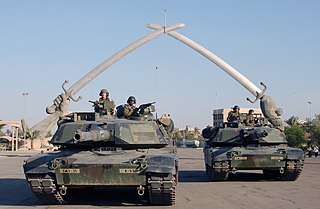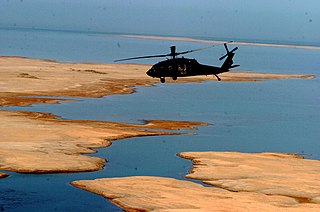
The following is a timeline of major events during the Iraq War, following the 2003 invasion of Iraq.

Baqubah is the capital of Iraq's Diyala Governorate. The city is located some 50 km (31 mi) to the northeast of Baghdad, on the Diyala River. In 2003 it had an estimated population of some 280,000 people.
Events in the year 2004 in Iraq.

After the 2003 invasion of Iraq was completed and the regime of Saddam Hussein was toppled in May 2003, an Iraqi insurgency began that would last until the United States left in 2011. The 2003–2006 phase of the Iraqi insurgency lasted until early 2006, when it escalated from an insurgency to a Sunni-Shia civil war, which became the most violent phase of the Iraq War.
Events in the year 2005 in Iraq.

The 2004 Iraq spring fighting was a series of operational offensives and various major engagements during the Iraq War. It was a turning point in the war; the Spring Fighting marked the entrance into the conflict of militias and religiously based militant Iraqi groups, such as the Shi'a Mahdi Army.
Events in the year 2007 in Iraq.

Operation Imposing Law, also known as Operation Law and Order, Operation Fardh al-Qanoon or Baghdad Security Plan (BSP), was a joint Coalition-Iraqi security plan conducted throughout Baghdad. Under the Surge plan developed in late 2006, Baghdad was to be divided into nine zones, with Iraqi and American soldiers working side by side to clear each sector of Shiite militias and Sunni insurgents and establish Joint Security Stations so that reconstruction programs could begin in safety. The U.S. military commander in Iraq, David Petraeus, went so far as to say Iraq would be "doomed" if this plan failed. Numerous members of Congress stated the plan was a critical period for the U.S. presence in Iraq.

The Diyala province campaign was a series of operations conducted by coalition forces against Iraqi insurgents and a number of bombing and guerrilla attacks against the security forces in Diyala Governorate of Iraq, with the purpose of control of the province.

Events in the year 2008 in Iraq.
The 2008 Nineveh campaign was a series of offensives and counter-attacks between insurgent and Coalition forces for control of the Nineveh Governorate in northern Iraq in early-to-mid-2008. Some fighting also occurred in the neighboring Kirkuk Governorate.
The 2008 al-Qaeda offensive in Iraq was a month-long offensive conducted by al-Qaeda in Iraq against the multinational coalition of USA, UK, Australia and Poland.
In 2003, there were 25 suicide bombings executed by 32 attackers.

This list details terrorist incidents occurring in Iraq in 2007. In 2007, the US sent 20,000 additional troops into combat as part of a troop surge. There were 442 bombings in 2007, the second-most in a single year during the Iraq War. Major events included a January 16 attack on Mustansiriyah University, which killed 70 and injured 180, and February 3 bombings at the Sadriyah market in Baghdad, which killed 135 people.

This is a list of terrorist incidents in Iraq during 2010. Major attacks include a 1 February attack killing 54 in Baghdad, and a 10 May attack killed 45 at a fabrics factory in Hillah.

The Iraqi insurgency was an insurgency that began in late 2011 after the end of the Iraq War and the withdrawal of U.S. troops from Iraq, resulting in violent conflict with the central government, as well as low-level sectarian violence among Iraq's religious groups.
During the first two weeks of July 2013, a series of coordinated bombings and shootings struck across several cities in Iraq, killing at least 389 people and injuring more than 800 others.
The following lists events that happened during 2014 in Iraq.
The following lists events the happened in 2013 in Iraq.








